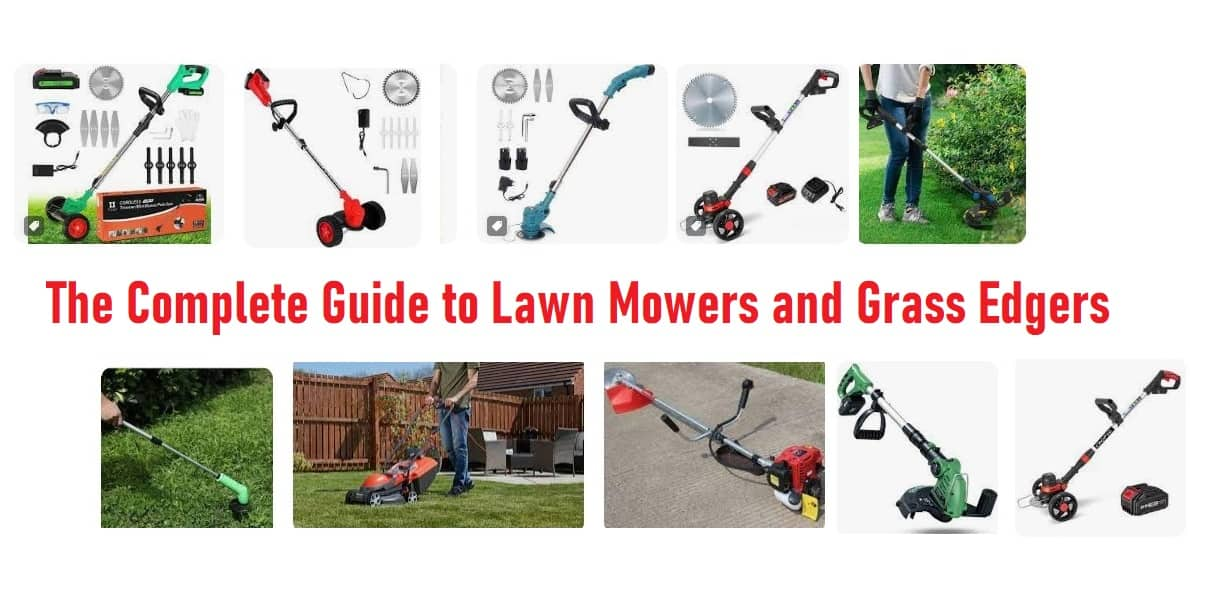Achieving a pristine lawn requires the right mowing and edging equipment. With so many options to choose from, this guide will walk through the pros and cons of different mower and edger types, features to look for, and tips to get the maximum benefit from your equipment investment.
Lawn Mower Types
Lawn mowers fall into three main categories:
Push Mowers
- Require manually pushing mower to cut grass
- Best for smaller, flat lawns under 1/4 acre
- Lower cost and minimal maintenance
- Options like self-propel reduce pushing effort
Pros
- Inexpensive
- Lightweight and maneuverable
- No gasoline or batteries needed
Cons
- Labor intensive on larger lawns
- Limited run time
Riding Mowers
- Sit atop mower powered by engine or battery
- Ideal for lawn sizes 1 acre and up
- Higher cost but excellent for hilly, uneven terrain
Pros
- Little physical exertion needed
- Large cutting swaths and fuel tanks for extended mowing
- Power and traction to handle slopes and rough terrain
Cons
- Expensive initial purchase price
- Ongoing maintenance needs
- Less maneuverability than push mowers
Robotic Mowers
- Automated battery-powered mowers operate unattended
- Programmable schedule allows autonomous operation
- Best for flat, fenced-in 1/4 to 1/2 acre lawns
Pros
- No effort after initial setup
- Scheduled cutting maximizes lawn health
- Very quiet operation
Cons
- High upfront investment
- Limited to smaller, simple lawn shapes
- Ongoing battery replacement
For most homeowners, a self-propelled push mower provides the best combination of affordability and sufficient power to handle yards up to 1/3 acre.
Gas vs. Electric Mowers
The two powered mower options use either gas engines or electric motors:
Gas Mowers
- Gasoline-powered with internal combustion engine
- Stronger power output than comparable electric
- Longer run times – up to 1-3 hours per tank
Electric Mowers
- Powered by rechargeable batteries
- Quieter, cleaner operation than gas
- Cordless flexibility but limited 1-2 hour run time
While electric mowers are growing in popularity, gas mowers remain the more powerful, durable choice for most full size lawns. Higher torque output handles thick, dense grass better. Those with smaller lawns under 1/4 acre will appreciate the convenience of electric.
Self-Propelled Mowers
Self-propelled mowers utilize a drive system to move the mower forward without needing to be manually pushed. Two main self-propel technologies exist:
Front Wheel Drive
- Drive wheels on front help pull mower forward
- Requires less user effort to steer and maneuver
Rear Wheel Drive
- Drive wheels in rear push mower forward
- Maintains natural controlled feel of a push mower
I recommend front wheel drive self-propelled mowers for flatter, obstacle-free lawns. The powered forward pull makes mowing effortless.
However, on uneven or hilly terrain, rear drive models provide better traction and prevent the mower from pulling you down inclines.
Key Mower Features
Whether choosing gas or electric, several features affect mowing experience:
Cutting Width
- Wider decks like 21-30 inches cut more grass in fewer passes
- Narrow decks 18-21 inches provide greater maneuverability
Cutting Height
- Ability to adjust blade height from 1-4 inches
- Allows cutting grass at optimal length for season
Mulching vs Bagging
- Mulching blades finely chop clippings into lawn
- Bagging collects clippings for composting
Speed Control
- Variable speed settings for throttle control
- Faster speed for thick grass; slower for precision trimming
Cruise Control
- Maintains constant speed without holding trigger
- Reduces hand fatigue for long mowing sessions
Headlights
- Illuminate lawn to allow mowing at night
- Help avoid obstacles and debris
Seek out mowers offering adjustable speed, cutting height, and bagging/mulching flexibility to handle various mowing needs.
Riding Mower Features
Riding mowers provide additional capabilities tailored to larger properties:
Cutting Width
- Deck sizes from 42-72 inches
- Wider decks up to 6 feet cut large swaths quickly
Transmission
- Automatic vs manual transmission
- Automatic offers easy speed control with pedal
Zero Turn
- Dual front wheels enable pivoting in place
- Allows mowing around obstacles easily
Power Steering
- Enables easy low-speed maneuvering
- Reduces arm strain when mowing long durations
Attachments
- Hauling carts to transport equipment and tools
- Snow plows, sweepers and tire chains for year-round use
Suspension
- Shock absorption for a smoother ride
- Reduces bouncing and jostling on uneven terrain
Seek out similar versatility for your unique mowing and yardwork needs.
Lawn Edgers
Edgers create crisp definition between grass and paved areas. Three main types exist:
Manual Edgers
- Use swinging or spinning blade action
- Require physical exertion to operate
- Least expensive option
Pros
- Very affordable
- Don’t require fuel or power source
Cons
- Tiring for large projects
- Limited depth control
Electric Edgers
- Powered by electric motor and cord
- Allow adjusting edging depth
- Moderate cost investment
Pros
- Minimal physical effort
- Affordable for most budgets
Cons
- Limited by cord length
- Not as powerful as gas
Gas Edgers
- Gasoline engine provides power
- Offer greatest edging depth flexibility
- Most expensive option
Pros
- No cords to limit range
- Best power for deep edge cuts
Cons
- Require fuel and maintenance
- Heavier than other options
For sufficient power to edge along driveways and cut crisp borders, a gas edger is the best choice. Electric models work fine for lighter occasional use.
Key Edger Features
When selecting an edger, look for:
Edging Depth
- Ability to adjust edging depth 2-6 inches
- Cleaner edges and neater distinctions between surfaces
Beveled Edging Blade
- V-shaped blade allows cleaner grass roots cuts
- Distinct trench helps contain grass growth
Cultivator Blade
- Opposite-facing blade de-thatches grass strip
- Prepares neat, defined trench edge
Handle Style
- T-shaped, loop or pistol grip
- Pick most comfortable and ergonomic for your height
Debris Shielding
- Deflectors block flying dirt and rocks
- Keep work area clean and prevent injury
Variable depth adjustment coupled with beveled edging blades allow customizing crisp, clean lawn borders.
Lawn Care Tips
Proper mowing and edging technique ensures a lush, healthy lawn:
- Mow early morning when grass is cool and dry
- Remove no more than 1/3 grass blade length per cut
- Mow frequently enough so no more than 1 inch is ever removed
- Leave 3-4 inch grass height to encourage deeper roots
- Sharpen mower blades regularly for clean cuts
- Alternate mowing direction each cut to avoid ruts
- Edge along walkways, drives and borders routinely
- Use edger guide to carve consistent trench depth
- Clean debris from under mower and edger after each use
Consistent mowing and edging establishes order and enhances the aesthetic appeal of your lawn.
Key Takeaways
- Self-propelled gas mowers offer the best value for average 1/4-1/3 acre lawns
- Electric mowers provide quiet convenient care for smaller yards
- Look for adjustable speed, cutting height and mulching/bagging capabilities
- Riding mowers allow quick mowing using attachments on larger properties
- Gas-powered edgers provide deepest cleanest trenches with effortless power
- Adjustable edging depth, beveled blades and debris shields optimize results
- Proper mowing and edging technique enhances lawn health and aesthetics
I hope this guide helps identify the ideal mower and edger for your unique lawn care needs. Let me know if you have any other lawn maintenance questions!







